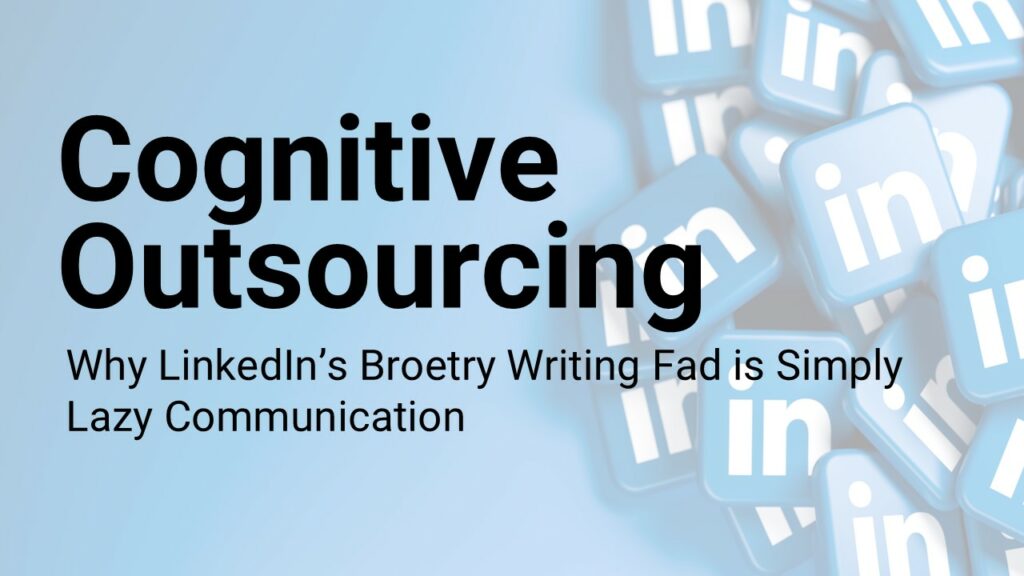On November 19, 2013, The Atlantic published Peter Norvig’s lament on the overuse of PowerPoint. It was the 150th anniversary of Lincoln’s Gettysburg Address, and to celebrate that speech, the magazine shared Norvig’s humorous portrayal of how that famous speech would have been delivered if Lincoln had written it in PowerPoint.
Norvig had gained some serious cred when he previously wrote, “Nobody should be surprised that PowerPoint does not measure up to the great speeches of history, such as Lincoln’s Gettysburg Address. And it is certainly a shame when a potentially interesting presentation is dumbed down by another formulaic over-application of PowerPoint.” Norvig appropriately noted that when the over-application “leads not just to boredom but to bad decisions, it is a tragedy, not just a shame.”
He concluded that PowerPoint “lowers the ceiling” of cognitive thought.
This conclusion is not limited to great speeches. Many in the corporate world share Norvig’s view. Data visualization expert Edward Tufte wrote, “The evidence indicates that PowerPoint, compared to other common presentation tools, reduces the analytical quality of serious presentations of evidence.” Jeff Bezos banned PowerPoint from business proposals at Amazon, citing that it compromised logical thinking. He also noted that using PowerPoint is “easy for the author and hard for the audience.” Writing narratives requires the author do the heavy lifting.
Those of us in the corporate world cheered these observations. Surely such an outcry from the cognoscenti should help us break the bonds of the bullets! Yet alas, they did not. Bullet-riddled writing still prevails, and now, like a virus mutating insidiously, an equally disconnected means of communication via texts and social media posts is emerging.
How Low Will the Ceiling Go?
You’ve likely seen it (or perhaps even used it)—a list of single sentences (or partial sentences) in which each line may or may not relate to the one before or after. It is very popular on LinkedIn.
It’s been called “broetry” and looks like this.
Mimic bad journalism.
Start with clickbait.
Write as if you are using PowerPoint bullets.
Avoid paragraphs at all costs.
Writing paragraphs requires increased brain functioning.
You are now experiencing a broem’s unnecessary line breaks.
Conjunction, junction, where art thou?
Where’s the beef?
Let’s be intentionally vague.
Imagine a movie script in broetry.
Is the whole world suffering from attention deficit disorder?
Now it is time for the meaningless cliché.
That’s a broem. As an anti-broem author noted, “I’m not sure where the hell it came from. But recently on LinkedIn, I’ve noticed this phenomenon where entrepreneurs, growth-hackers, and digital marketers are posting poorly written self-help-like ‘prose’ littered with clichés and vague blanket statements.”
A blogger called it “corporate essay-poetry” while another noted, “This is very third-grade-level writing style.” My favorite characterization is by Carine Rampelt: “It’s like making a speech and dropping the mic after very phrase.”
Imagine if Lincoln’s Gettysburg Address had used this form:
A nation was founded 87 years ago.
All men are created equal.
We’re engaged and being tested in a great civil war.
We should dedicate this battlefield of that war.
A lot of people died here.
Consider the broader perspective.
You and I cannot dedicate it.
Those who struggled and died here have already done that.
We have unfinished work to do.
People gave their last full measure of devotion here.
We are highly resolved they did not die in vain!
This nation and government shall not perish from the earth.
Note how this broetry rewrite loses the power and poignancy of Lincoln’s eloquently crafted speech that persuaded a nation. If you are seeking to persuade, writing in this style results in similar losses. You want me to accept your proposal? Consider the value of your expertise? Buy into your argument?
Then give me the following:
- What is the specific challenge you want me to address?
- Why should that be important to me?
- Where is the use of contrasts or comparisons to help me understand?
- What is the broader cause you want me to attend to?
- What is the call to action?
Humans rely on these essential elements to be persuaded; broets ignore the harder work of providing them.
An Abdication of Cognitive Effort In Today’s Communication
Not unlike its bulleted ancestor named PowerPoint, broetry allows authors to abdicate cognitive effort. Instead of tackling the difficult work of developing compelling narratives or cases that logically build toward a central premise, the broet outsources that work to the audience. In doing so, they fail to leverage the brain’s natural mechanisms of engagement.
- Structure matters to the brain. As Bezos correctly noted, communications that are “structured with real sentences, topic sentences, verbs, and nouns” are much more effective. Human brains process words embedded in basic sentence structures in milliseconds, as compared to words that float with no place. The brain pays more attention to sentences than to unstructured lists of words.
- Stories engage the brain. The structuring, sequencing, and developing of relationships of those sentences matter to the brain. Multiple studies have demonstrated that using a story-based style improves learning and information retention. In a good story, the reader connects with and understands the writer’s leading point through their use of carefully constructed and sequenced insights, logic, and emotion. Stories create the context for the elements.
- Convergence matters to the brain. Leaving your reader with what essentially looks like a wall full of divergent Post-its frustrates your audience. Human brains don’t like ending in divergence. What was the purpose of this? What’s the conclusion?
Because broetry is the equivalent of cognitive outsourcing to the audience (making comparisons, synthesizing concepts, and developing insights), the audience never sees anything building toward the essence. We are left searching for the substance, the core that binds the list together.
I’m a passionate learner, and I am interested in what you have to say or offer.
If you don’t have the time to carefully construct your point, if you haven’t yet honed your assertion, if you simply compile disconnected sentences in a poetry-esque shape that leaves it to me—your audience—to exert more cognitive effort than you as I attempt to discern the essence of your post, I will scroll on by.
Why should I work harder than you?
NOTES
https://www.theatlantic.com/technology/archive/2013/11/the-gettysburg-addressas-
a-powerpoint/281636/
https://www.livescience.com/health/neuroscience/our-brains-can-understandwritten-
sentences-in-the-blink-of-an-eye-study-reveals).
https://mannerofspeaking.org/2010/11/19/the-gettysburg-address-an-analysis/
https://www.inc.com/justin-bariso/amazon-jeff-bezos-powerpoint-meetings-how-tothink.
html
https://www.fenwick.media/all-blog-posts/mastery/broetry-dead-broets-society

